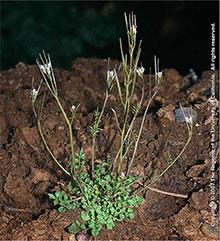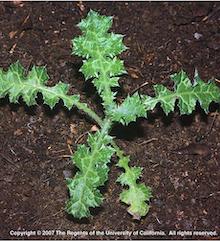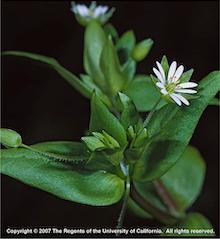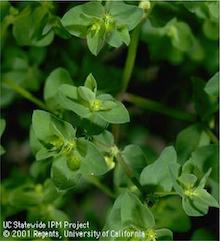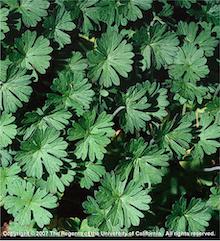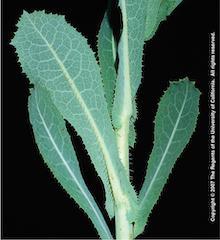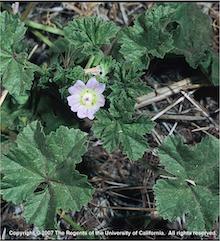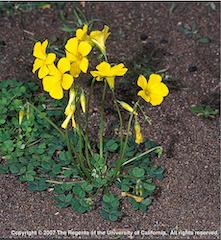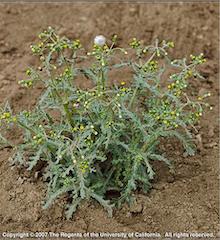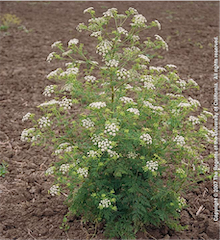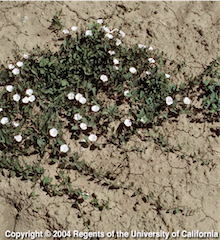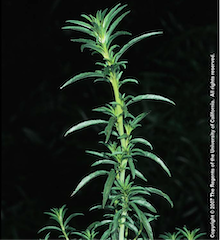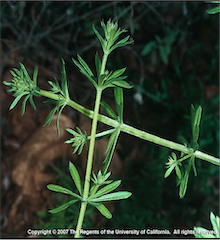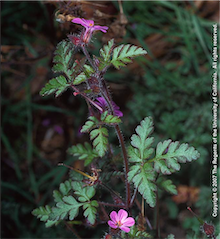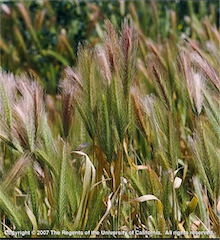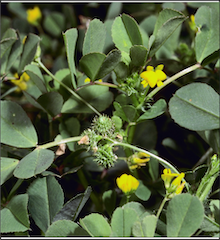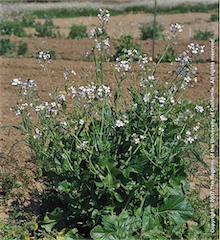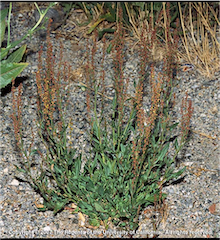| Poison hemlock (Conium maculatum) is similar in appearance to carrots and celery but toxic if ingested and may cause dermatitis if handled. It can usually be identified by the presence of purple spots or streaks on the stem although some individuals lack this trait. Annual removal by hand pulling, cutting the stem at ground surface, or mowing before it produces seed will control poison hemlock over time. Be sure to wear gloves when handling. For more information, click here. |
Field bindweed (Convolvulus arvensis) is a herbaceous perennial plant with arrowhead-shaped leaves and an extensive system of deep, creeping roots. The vining stems of bindweed spread along the ground or wind through other plants, binding the foliage as they grow. This plant is extremely difficult to control. Deep cultivation before flowering and repeated cultivation when new shoots appear is somewhat effective if done on a regular basis. For more information click here. |
Willowherb (Epilobium spp.) includes several native species that can become weedy in the garden. Depending on the species, willowherbs may be perennial or annual, but both kinds are tall (up to 6 ft), and single stemmed or bushy in appearance, with small flowers and slender capsules that bear seeds. Willowherbs can be controlled in the garden by hand pulling or cultivation before they set seed. For more information click here. |
|
Catchweed bedstraw or cleavers, (Galium aparine) is an annual plant with square stems, whorled leaves, and inconspicuous flowers. It is found intertangled in or climbing on other plants in the garden. The foliage and fruits are covered with tiny curved prickles that cling to clothing and fur. Manual removal or cultivation before plants develop fruits will control this plant. For more information, click here.
|
Herb-Robert (Geranium robertianum) is an annual or biennial plant with malodorous, dissected foliage, small pink flowers, and a slender taproot. This plant will grow in open or shady areas, and may hide beneath the foliage of other plants in the garden. Like other geraniums, herb-Robert should be pulled, dug up, or cultivated before flowers and seeds are produced. For more information click here.
|
Foxtails (Hordeum marinum and H. murinum), also known as Mediterranean and hare barley, are annual grasses with dense, bristly spikes. Mature foxtails have stiff, barbed awns that are hazardous to pets if consumed, inhaled, or lodged in ears. Small infestations can be removed by digging or hand pulling. Larger areas should be mowed prior to spike formation. For more information, click here and here.
|
| California burclover (Medicago polymorpha) is an annual plant with stems up to two feet long that usually trail along the ground, creating dense mats. Burclovers have leaves comprised of three leaflets and small yellow flowers that mature into a prickly bur. Burclover can be controlled by hand pulling, hoeing, cultivation, and application of mulch. For more information click here. |
Wild radish (Raphanus raphanistrum, R. sativus) are annual or biennial weeds that exist as rosettes until a stout, often woody flower stem develops. The small, pale flowers vary in color and have four petals arranged in a maltese cross formation. Control by digging up the rosettes before they bolt. Larger plants should be removed by shovel or cut at the base before flowering. For more information, click here. |
Red Sorrel (Rumex acetosella) is a herbaceous plant with arrowhead-shaped leaves, trailing stems and creeping roots. Clusters of tiny flowers mature into a reddish-brown head of grain-sized, three-sided fruits. Sorrel both reproduces by seed and spreads by creeping roots. It is difficult to control but can be kept in check by periodically digging up the plants, removing as much of the root system as possible. For more information, click here. |

